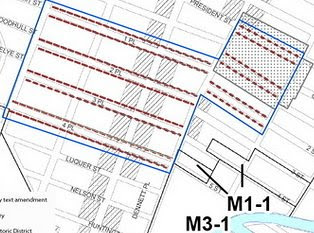 We’re not certain there is any organized opposition to the zoning text amendment that will redefine a number of narrow Carroll Gardens streets as being, in fact, narrow rather than “wide,” but residents aren’t taking any chances. They’ve started a letter-writing campaign to show their support to Planning Chair Amanda Burden, Brooklyn Planning Director Purnima Kapur, Borough President Marty Markowitz, City Council Member Bill de Blasio, Members of Commmunity Board 6 and others. A letter is now circulating in advance of a Community Board 6 Land Use Committee meeting on the change on April 24 at 6PM (at 250 Baltic Street). The letters will be presented by the CORD group, which has campaigned hard for this change and overall downzoning of Carroll Gardens. There is a “property owner” and “resident” version of the letter. Here’s the resident version:
We’re not certain there is any organized opposition to the zoning text amendment that will redefine a number of narrow Carroll Gardens streets as being, in fact, narrow rather than “wide,” but residents aren’t taking any chances. They’ve started a letter-writing campaign to show their support to Planning Chair Amanda Burden, Brooklyn Planning Director Purnima Kapur, Borough President Marty Markowitz, City Council Member Bill de Blasio, Members of Commmunity Board 6 and others. A letter is now circulating in advance of a Community Board 6 Land Use Committee meeting on the change on April 24 at 6PM (at 250 Baltic Street). The letters will be presented by the CORD group, which has campaigned hard for this change and overall downzoning of Carroll Gardens. There is a “property owner” and “resident” version of the letter. Here’s the resident version:
I am a Carroll Gardens resident. I may or may not be able to attend all of the public hearings and meetings in regard to the proposed zoning text amendment referenced in the land use application above, so I wish to go on record by voicing my opinion now.
I am in favor of this zoning text amendment change. I believe that this is a long overdue, much welcomed relief to some of the problems Carroll Gardens has been facing due to the increase in new residential development. It pleases me that these streets, First through Fourth Places, between Smith and Henry Streets, Second, Carroll and President Streets between Smith and Hoyt, may no longer be subject to a regulation which allows boulevard sized, out of character structures to be built upon them. It is my wish that the members of our Community Board and Borough President Markowitz, heartily recommend Carroll Gardens Zoning Text Amendment N080345ZRK.
I want to thank the Department of City Planning for introducing this wonderfully creative solution and Councilman DeBlasio for his continued support. Further, I fervently hope that once the public hearings are over, both the City Planning Commission, and the City Council will make every possible effort to proceed as swiftly as possible to get this changed enacted.
One activist we spoke with called the letter and its widespread distribution in the neighborhood “a true sign of grassroots solidarity.”
